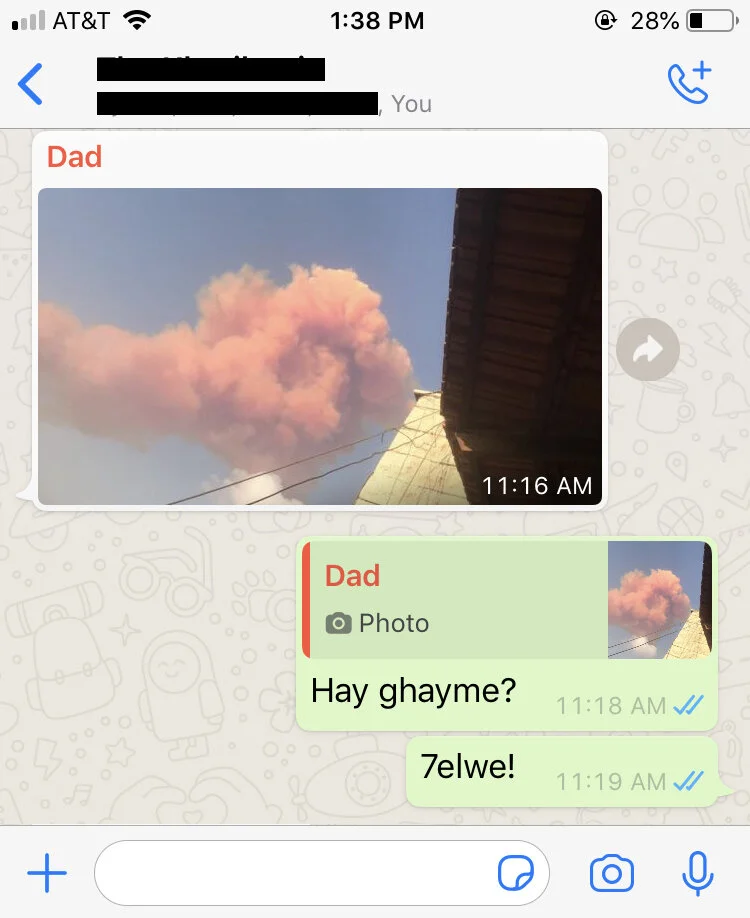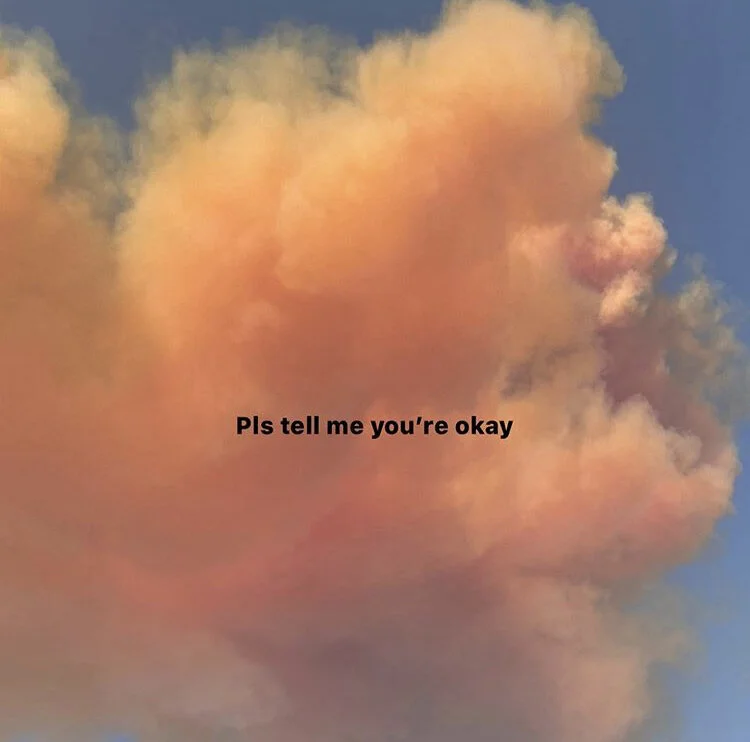We owe ourselves to death
by Sahar Khraibani
1.
Pls tell me you’re okay.
On the family WhatsApp group, my father sends a photograph taken from our house’s balcony, a pink cloud formation invading a clear blue sky. No caption. “Hay ghayme? 7elwe!” (Is this a cloud? It’s beautiful!) I responded, thinking that my father was sharing with me a blissful moment, a beautiful sunset bleeding into a water-blue sky. And then, nothing. For a little while, I continued my day, working or writing, performing some task or another.
I retreat to Instagram, browsing through posts and stories. A photo by Myriam Boulos was circulating, replicated and repeated, reposted, reshared, the same beautiful cloud my father sent me a picture of, but this one with text overlaid: “Pls tell me you’re okay.”
Panic sets in. I realize that my parents probably lost service. An explosion. A big one. Information mixed with rumors trickled in slowly. Within the hour, we knew it was a massive explosion, although questions remained. Was it nuclear? Was it an attack? Was it poisonous? That hour, from a distance of five thousand six hundred and nine miles away, seemed to stretch on forever. In a state of emergency, time loses value—it goes suspended indefinitely, gets stretched and sped up. It loses any quality it previously retained.
The image [a cloud, chemical blast, 2,750 tons of ammonium nitrate, left unattended, for six whole years] produced itself, each time, for the first time, and yet all the same—a testament: “we owe ourselves to death.”
2.
We owe ourselves to death.
The cloud hovers above ruins, a distraction, derailment: of death and destruction and a city buried. The photograph is a close-up, a cropped section of the fluorescent pink cloud caused by the explosion, taking over the border and the sky. It occupies more than a third of the picture frame.
Derrida recasts an epitaph from Athens: “Nous nous devons à la mort,”* ‘we owe ourselves to death,’ as an approach to understanding the implicit morbidity of photography. While he was reading this phrase through Jean-François Bonhomme’s photographs that juxtapose the ruins of ancient Athens with contemporary scenes of a city riddled with ruin and death, Derrida goes on to interrogate a philosophical tradition in which human nature is defined by its proximity to its inevitable end. He ruminates: “never do any of these photographs fail to signify death. Each signifies death without saying it. Each one, in any case, recalls a death that has already occurred, or one that is promised or threatening, a sepulchral monumentality, memory in the figure of ruin.” Photographs, by nature, are a record. In the case of Boulos’, it was a record of irretrievable loss: a city, in ruins, a city that was perhaps living on already borrowed time even at the moment of its demise.
While Heidegger denounced photography as a medium that erases instead of records in that it “replaces the authentic experience,” for the diaspora,** photographs compensate for our lack of physical presence. But at the same time, they dull down noise, our senses, a blast, the thud of a body, the shattering of glass, all becomes obsolete. Distance is at once lifesaving and deadly. It normalizes, desensitizes, declares us prisoners to two-dimensionality. But some photographs evade this destiny and allow us to not normalize, not brush it off, not replace and instead linger in the fact that it is not okay. It is not okay.
The photograph posted on Boulos’ Instagram account is unlike any of her usual photographic work. Known for photojournalistic takes that lean more towards the observational—at times confrontational, with the use of overexposure—this struck a different chord. “Pls tell me you’re okay.”
Boulos’ photograph anchors what could be perceived as a site of beauty within the peripheries of terror. What was once beautiful stops being so by virtue of becoming a menace: a dark devouring entity. It is a testament to this meeting of opposite ends: life and death, beauty and terror. The real irony in the overlay of text on image is that nothing has been okay, that there is no getting used to this, that mere survival is not enough of an indicator of normalcy. Boulos’ photographic record declares that this particular act of human atrocity has been seen, that it has been documented, that this juxtaposition between the elements has been recorded. In juxtaposing the picturesque beauty of a cloud with an inquisition related to safety, the artist brings to the front how the duplicitous nature of beauty lies in its ability to stealthily portend demise.
In an interview with Plastik Magazine dating from July 19, 2020, nearly 20 days before the blast, Boulos shares: “I have always felt a deep connection between the city and the body I live in.” The body keeps the score, and it has learned to measure time in two different ways: before and after the blast, both brief, both in photographs.
* Derrida, Jacques (2010) In Athens, still remains. Ashland, OH: Fordham University Press.
** There are more Lebanese living outside Lebanon (4 - 8 million), than within the country (4m)
3.
And our faces,
my heart,
brief as photos.
To photograph is to resist. For some, it is a reflex: an instinct to document, to make sure this is happening, to gather proof that what you’re seeing is real. But resistance is more than a reflex, more than the body’s primitive refusal of what it knows to be an injustice. It is an act of creating and having authorship over what is immediately and irredeemably taken out of its hands. Resistance mounts, it invades skies, enters thoughts, pierces hope. It allows for explanations of the world. It is a declaration: a body is not only resistant, it is militant.
Photographs are insinuations. Borrowed from the Latin insinuo, meaning “to push in, or creep in,” the act of insinuating is a creeping, winding, or flowing in. An insinuation is also a suggestion, an innuendo, or intimation by distant allusion. Photographs, and the way we see and receive them, are embedded within complex patchworks of memory. Sometimes what we can insinuate is more powerful than the explicit in that it brushes up against the unsayable, unnamable vastness of the impact of a traumatic event. They’re never innocent or just aesthetic or romantic; they’re question marks. They’re constructs. They are never just about physical space or territory: they are about timelines, conditions of being, and the state of inescapable impermanence. In a way, the more beautiful and arresting they are, the more we are compelled to contemplate why and how they have the power to make us believe that they offer some kind of escape. They possess in them narratives and questions that go beyond geology, nature, and the picturesque: they give us the desire to resist, to refuse, to live at the dimensions that are ours. Dimensions that are stolen from us, dimensions that tire us and rob us of a life: to live is to resist what it is to be from a country eroded by corruption, robbed even of hope.
In the same interview from July 19, 2020, Boulos declares that once the lockdown due to COVID-19 is over: “I have a huge desire to take pictures of life, in all its forms.” No one could tell that the absence of life would become one of these forms, on the first day “free” of lockdown, taking shape as a tragic cloud in Boulos’ photograph, looming over ruins, a record and an image of the presence of absence.
My thoughts, prayers, and words go out to all those who lost their lives to this tragic manifestation of complete negligence for human life, and those who survived to tell the tale, to resist, rebuild, and fight for nothing more than life itself.
Sahar Khraibani is a Lebanese writer, artist, and educator based in New York. She is interested in the intersection between language, artistic production, and geopolitics, as well as the digital reproducibility of trauma. Her writing and work have appeared in the Brooklyn Rail, Hyperallergic, TERSE Journal, Degree Critical, The Outpost, Queen Mobs, Full Stop, and Bidayat Mag, among others. She co-runs @duriandays, a studio-collective and online platform for BIQPOC creatives, and currently serves as faculty at Pratt Institute.
Myriam Boulos graduated with a master degree in photography from the Academie Libanaise des Beaux Arts in 2015. She took part in both national and international collective exhibitions, including Photomed, Beirut Art Fair, Berlin PhotoWeek, Mashreq to Maghreb (Dresden, Germany), Beyond boundaries (New York), C’est Beyrouth (Paris) and 3ème biennale des photographes du monde arabe (Paris). She received the Byblos Bank Award for Photography in 2014, which lead to her first solo exhibition at the Byblos Bank in April 2015. Her second solo exhibition took place at the French institute of Lebanon in 2019. Myriam uses her camera to question the city, its people, and her place among them. Her photography is a mix of documentary and personal research.


